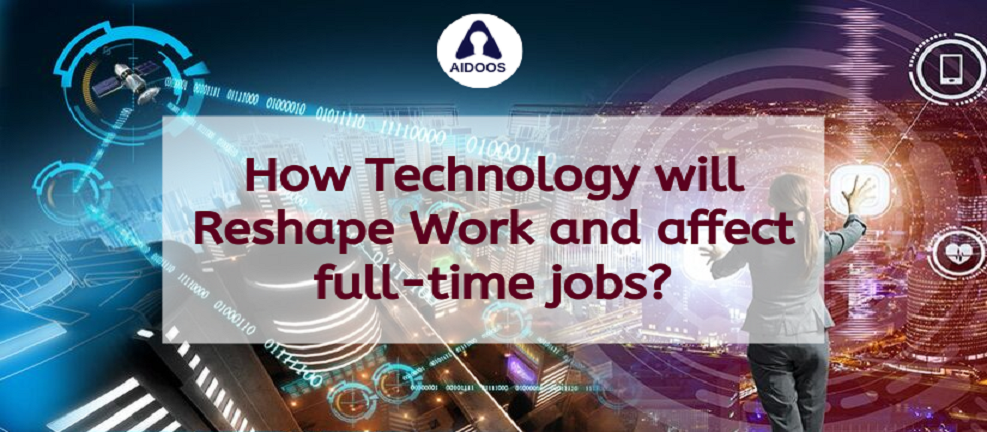How Technology Will Reshape Work: Insights for CIOs, CTOs, and IT Leaders

The workplace as we know it is undergoing a tectonic shift, driven by emerging technologies like AI, IoT, cloud computing, and extended reality. These disruptions are not just changing how businesses operate but also redefining the roles of employees and leadership. For CIOs, CTOs, and IT leaders, staying ahead of this technological evolution is no longer optional—it’s imperative for survival and growth.
Companies that fail to adapt, like the 178-year-old Thomas Cook, have faced the consequences. In contrast, forward-thinking organizations are leveraging technology to create transparent, efficient, and innovative workplaces. This blog delves into the critical ways technology is reshaping work and provides actionable insights for IT leaders to harness these changes effectively.
1. Human-Machine Collaboration: Building Interconnected Workspaces
Technology is driving deeper integration between human and machine intelligence. This collaboration fosters transparency, efficiency, and unbiased decision-making. For example:
Unbiased Talent Evaluations: Machine intelligence eliminates human biases in hiring and performance evaluations, ensuring a merit-based workforce.
Global Remote Collaboration: Tools like extended reality and teleconferencing connect on-site teams with remote experts, enhancing productivity.
Remote Inclusivity: Platforms like Upwork showcase the growing trend of location-neutral jobs, with millions of tasks completed annually by freelancers worldwide.
Actionable Insight for IT Leaders: Leverage technologies like AI-powered hiring tools and immersive collaboration platforms to build a globally interconnected workforce. Embrace co-working models and foster partnerships with remote specialists to maximize efficiency and talent diversity.
2. Automation Powered by Artificial Intelligence
Automation is no longer limited to repetitive tasks. AI is transforming workflows by:
Handling Rule-Based Tasks: AI-driven tools manage algorithmic processes, freeing human employees to focus on complex, strategic tasks.
Enhancing Workforce Productivity: By automating mundane activities, organizations reduce overheads and increase profitability.
Driving Relaxed Work Culture: With automation managing routine operations, employees can engage in higher-value, less stressful roles.
For instance, automation in industries like robotics is rapidly replacing human intervention in mechanical processes. Reports suggest that 38% of jobs in the US will become automated by 2025, pushing organizations to integrate AI into their business frameworks.
Actionable Insight for IT Leaders: Integrate automation into core processes to reduce inefficiencies. Focus on upskilling your workforce to manage, analyze, and complement AI tools, ensuring a seamless transition to a tech-driven ecosystem.
3. Problem-Solving Over Deadlines: A Creative Shift
The traditional emphasis on rigid deadlines is giving way to creativity and problem-solving. In the future:
Creativity and Analysis: Employees will focus on brainstorming, interpreting data, and creating innovative solutions rather than simply completing tasks.
Remote Hiring: Equal opportunities for talent across regions will become the norm, facilitated by global hiring platforms and virtual workspaces.
Upskilling Imperatives: Basic technical understanding of cloud computing, AI, and other emerging technologies will be prerequisites for most roles.
Actionable Insight for IT Leaders: Encourage a culture of continuous learning and innovation. Invest in training programs that focus on creativity, problem-solving, and emerging technologies to ensure your workforce remains competitive.
As IT leaders, your role is pivotal in navigating the evolving landscape. Here’s how you can stay ahead:
1. Embrace Virtual Delivery Centers (VDCs)
VDCs enable seamless integration of human and machine intelligence while offering flexibility and scalability. By leveraging VDCs, CIOs and CTOs can:
Access a global pool of specialized talent.
Scale resources dynamically to meet project demands.
Manage multiple projects efficiently using integrated tools.
2. Adopt AI-Driven Tools
Use AI-powered analytics to identify trends and optimize decision-making.
Implement AI in workflows to automate repetitive tasks, improving efficiency and reducing costs.
3. Foster a Learning Organization
Collaborate with platforms like AiDOOS that provide access to training resources and co-working spaces.
Encourage employees to participate in upskilling programs focused on emerging technologies.
4. Redefine Metrics of Success
Shift focus from rigid timelines to outcomes that prioritize creativity, innovation, and customer satisfaction.
Use data-driven insights to measure team performance and business impact.
Virtual Delivery Centers (VDCs) are the cornerstone of the future workplace. These platforms empower businesses to thrive in the digital age by providing:
Scalability and Flexibility: Adjust resources on demand to match project requirements without the overhead of traditional hiring.
Global Talent Access: Tap into a network of Subject Matter Experts (SMEs) for high-quality, specialized work.
Integrated Management Tools: Streamline workflows and monitor progress with built-in project management systems.
Cost Efficiency: Save on infrastructure and operational costs while maintaining high standards of delivery.
AiDOOS exemplifies this model, enabling organizations to adapt swiftly to technological disruptions while maintaining a competitive edge.
Technology is reshaping the work landscape, bringing opportunities and challenges. For CIOs, CTOs, and IT leaders, the key to staying ahead lies in embracing innovation, fostering adaptability, and leveraging platforms like AiDOOS. By integrating AI, automation, and VDCs into their strategies, organizations can build resilient, forward-thinking ecosystems ready to tackle the future of work.

For modern telecom enterprises, delivering exceptional QoS is no longer optional—it’s a brand differentiator and a strategic lever for growth. Static provisioning models won’t cut it in a world of hyper-dynamic data usage.